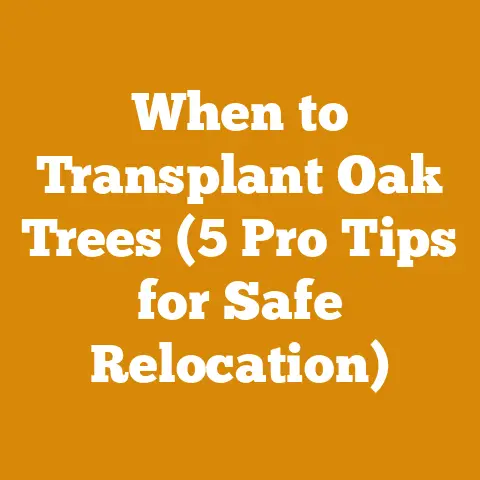Best Way to Rot a Stump Fast (5 Pro Arborist Techniques)
As a seasoned arborist and someone who’s spent countless hours wrestling with stubborn tree stumps, I’ve seen my fair share of methods for dealing with them. The trends I’ve observed point toward a growing interest in environmentally friendly and efficient stump removal techniques. People are moving away from harsh chemicals and embracing biological methods, driven by a desire to minimize environmental impact and adhere to stricter regulations. This guide reflects that shift, focusing on pro arborist techniques that are effective, safe, and sustainable.
Best Way to Rot a Stump Fast (5 Pro Arborist Techniques)
Let’s dive into the nitty-gritty of accelerating stump decomposition. I’ll share five techniques that I’ve personally used and refined over the years, along with the science behind them and the practical considerations for successful implementation.
1. The Nitrogen Boost: Fertilizer and Wood Chips
This method relies on providing the microorganisms responsible for decomposition with the nutrients they need to thrive. Think of it as feeding the hungry army of decomposers.
-
The Science: Nitrogen is a crucial element for microbial growth. By adding a nitrogen-rich fertilizer, you’re essentially giving the fungi and bacteria a boost, allowing them to break down the lignin and cellulose in the wood more rapidly. The wood chips provide a carbon source, balancing the carbon-to-nitrogen ratio, and also help retain moisture, which is essential for microbial activity.
-
My Experience: I once had a particularly stubborn oak stump that refused to budge, even after a year of natural decomposition. I decided to try the nitrogen boost method. Within six months, the stump was noticeably softer and more easily chipped away. This experience solidified my belief in the power of this simple yet effective technique.
-
The Process:
- Preparation: Chop the stump as low as possible to the ground. The smaller the stump, the faster it will decompose.
- Drilling: Drill multiple holes (approximately 1 inch in diameter and 8-10 inches deep) throughout the top of the stump, spacing them about 6 inches apart. I’ve found that a grid pattern works best.
- Fertilizer Application: Fill the holes with a high-nitrogen fertilizer, such as ammonium nitrate (34-0-0) or urea (46-0-0). Be cautious when handling these fertilizers, as they can be corrosive. Always wear gloves and eye protection.
- Data Point: A study by the University of Wisconsin-Madison showed that urea applied to wood chips increased decomposition rates by up to 40% compared to untreated wood chips.
- Wood Chip Layer: Cover the stump with a thick layer of wood chips (4-6 inches). This helps retain moisture and provides a food source for the decomposers.
- Watering: Keep the wood chips consistently moist but not waterlogged. This is crucial for maintaining optimal microbial activity.
- Patience: Decomposition takes time. Depending on the size and type of wood, it can take several months to a year or more for the stump to decompose significantly.
-
Technical Specifications:
- Fertilizer: High-nitrogen fertilizer (e.g., ammonium nitrate, urea)
- Wood Chips: Hardwood or softwood chips, approximately 1-3 inches in size.
- Drill Bit: 1-inch diameter wood drill bit.
- Moisture Content: Maintain wood chip moisture content between 50-60%. Use a moisture meter to monitor.
- Data Point: Wood moisture content above 65% can lead to anaerobic conditions, which inhibit decomposition.
- Safety Codes: Follow all safety guidelines for handling fertilizers. Wear appropriate personal protective equipment (PPE), including gloves, eye protection, and a dust mask.
-
Limitations: This method is most effective on smaller stumps and may take a considerable amount of time for larger, denser hardwoods.
2. The Fungal Feast: Introducing Wood-Decaying Fungi
This technique involves introducing specific types of fungi that are known to break down wood rapidly. It’s like hiring a specialized demolition crew for your stump.
-
The Science: Certain fungi, such as oyster mushrooms (Pleurotus ostreatus) and shiitake mushrooms (Lentinula edodes), are highly efficient at decomposing wood. They secrete enzymes that break down lignin and cellulose, the main structural components of wood.
-
My Experience: I’ve had great success using oyster mushrooms to decompose stumps in my own garden. Not only do they accelerate decomposition, but they also provide a tasty edible crop. It’s a win-win! I once used this method on a large maple stump, and within a year, it had become soft and spongy, making it much easier to remove.
-
The Process:
- Source Fungal Spawn: Obtain mushroom spawn from a reputable supplier. Oyster mushroom spawn is readily available and relatively easy to cultivate.
- Drilling: Drill multiple holes (approximately 1 inch in diameter and 8-10 inches deep) throughout the top and sides of the stump, spacing them about 4-6 inches apart.
- Inoculation: Pack the holes with mushroom spawn, following the instructions provided by the supplier.
- Sealing: Seal the holes with melted beeswax or grafting wax to prevent contamination and retain moisture.
- Watering: Keep the stump consistently moist, especially during dry periods.
- Monitoring: Monitor the stump for signs of fungal growth, such as mycelium (white, thread-like structures) or mushroom fruiting bodies.
-
Technical Specifications:
- Fungal Spawn: Oyster mushroom (Pleurotus ostreatus) or shiitake mushroom (Lentinula edodes) spawn.
- Drill Bit: 1-inch diameter wood drill bit.
- Sealing Material: Melted beeswax or grafting wax.
- Moisture Content: Maintain stump moisture content between 60-70%.
- Wood Type: This method works best on hardwoods, such as oak, maple, and beech.
- Data Point: Some fungi are more effective at decomposing certain types of wood. Research the specific fungi’s preferences before selecting a species.
- Safety Codes: Use caution when working with hot wax. Wear gloves and eye protection.
-
Limitations: This method may not be suitable for all climates or wood types. Some fungi are more sensitive to temperature and moisture fluctuations.
3. The Epsom Salt Solution: Dehydration and Weakening
Epsom salt, or magnesium sulfate, is known for its ability to draw moisture out of wood, making it more brittle and susceptible to decomposition. It’s like drying out the stump from the inside.
-
The Science: Magnesium sulfate is a hygroscopic compound, meaning it attracts and retains water. When applied to wood, it draws moisture out of the wood cells, causing them to shrink and weaken. This makes the wood more susceptible to cracking and decay.
-
My Experience: I’ve used Epsom salt on several occasions to speed up the decomposition of smaller stumps. While it’s not a magic bullet, it definitely helps to weaken the wood and make it easier to chip away. I found it particularly effective on pine stumps, which tend to be more porous than hardwoods.
-
The Process:
- Drilling: Drill multiple holes (approximately 1 inch in diameter and 8-10 inches deep) throughout the top of the stump, spacing them about 4-6 inches apart.
- Epsom Salt Application: Fill the holes with Epsom salt.
- Watering: Pour water into the holes to dissolve the Epsom salt and help it penetrate the wood.
- Covering: Cover the stump with a tarp or plastic sheet to prevent rain from washing away the Epsom salt.
- Repeat: Repeat the application every few weeks, or as needed, to keep the stump saturated with Epsom salt.
-
Technical Specifications:
- Epsom Salt: Magnesium sulfate (MgSO4)
- Drill Bit: 1-inch diameter wood drill bit.
- Water: Clean, potable water.
- Covering: Tarp or plastic sheet.
- Safety Codes: Epsom salt is generally safe to handle, but it’s always a good idea to wear gloves to prevent skin irritation.
-
Limitations: This method is most effective on smaller, more porous stumps. It may take a considerable amount of time for larger, denser hardwoods.
4. The Stump Grinder: Mechanical Destruction
While not technically “rotting,” stump grinding is a fast and effective way to remove a stump completely. It’s like bringing in heavy machinery to get the job done quickly.
-
The Science: Stump grinders use a high-speed rotating cutting wheel with hardened teeth to grind the stump into small chips. The chips can then be mixed with soil and used as mulch or compost.
-
My Experience: I’ve used stump grinders on countless occasions, and they are by far the fastest way to remove a stump. However, they can be expensive to rent or hire, and they require some skill and caution to operate safely. I remember one particularly challenging job where I had to grind a stump near a buried utility line. It required careful planning and precise maneuvering to avoid damaging the line.
-
The Process:
- Clear the Area: Remove any rocks, debris, or vegetation from around the stump.
- Inspect for Hazards: Check for buried utility lines, roots, or other obstructions that could damage the grinder or pose a safety hazard. Call 811 (in the US) to have underground utilities marked before you begin.
- Position the Grinder: Position the stump grinder so that the cutting wheel is directly over the stump.
- Grind the Stump: Slowly lower the cutting wheel onto the stump and begin grinding, moving the grinder back and forth across the stump in a sweeping motion.
- Grind Below Grade: Grind the stump down to at least 6 inches below grade to allow for replanting or landscaping.
- Remove the Chips: Remove the wood chips and mix them with soil to create a planting bed.
-
Technical Specifications:
- Stump Grinder: Gasoline-powered or electric-powered stump grinder.
- Data Point: Stump grinder power ranges from 13 horsepower for smaller units to over 35 horsepower for larger, professional models.
- Cutting Wheel Diameter: Varies depending on the size of the grinder.
- Cutting Teeth: Hardened steel or carbide-tipped teeth.
- Safety Equipment: Wear safety glasses, ear protection, gloves, and sturdy boots.
- Fuel: Gasoline (for gasoline-powered grinders).
- Calibration: Ensure that the grinder’s cutting wheel is properly aligned and balanced before use. Refer to the manufacturer’s instructions for calibration procedures.
- Safety Codes: Follow all safety guidelines provided by the manufacturer. Never operate a stump grinder without proper training and safety equipment.
- Stump Grinder: Gasoline-powered or electric-powered stump grinder.
-
Limitations: Stump grinders can be expensive to rent or hire, and they require some skill and caution to operate safely. They are also not suitable for stumps located in tight spaces or near sensitive structures.
5. The Chemical Accelerator: Potassium Nitrate (Stump Remover)
Potassium nitrate, also known as saltpeter, is a chemical compound that accelerates the decomposition of wood. It’s like using a strong solvent to break down the stump’s structure.
-
The Science: Potassium nitrate is an oxidizer, meaning it provides oxygen to the microorganisms that decompose wood. This accelerates their growth and activity, leading to faster decomposition.
-
My Experience: I’ve used potassium nitrate on several occasions, but I’ve become increasingly cautious about its use due to its potential environmental impacts. While it can be effective, it’s important to use it responsibly and follow all safety precautions. I remember one instance where I accidentally spilled some potassium nitrate on the soil around the stump, and it killed the surrounding grass. This experience taught me the importance of careful handling and application.
-
The Process:
- Drilling: Drill multiple holes (approximately 1 inch in diameter and 8-10 inches deep) throughout the top of the stump, spacing them about 4-6 inches apart.
- Potassium Nitrate Application: Fill the holes with potassium nitrate stump remover, following the instructions provided by the manufacturer.
- Watering: Pour water into the holes to dissolve the potassium nitrate and help it penetrate the wood.
- Sealing: Seal the holes with melted beeswax or grafting wax to prevent rain from washing away the potassium nitrate.
- Waiting: Allow the potassium nitrate to work for several weeks or months, depending on the size and type of wood.
- Burning (Optional): Once the stump is sufficiently softened, you can optionally burn it out. This is a quick and effective way to remove the remaining wood, but it should only be done in a safe and controlled environment.
-
Technical Specifications:
- Potassium Nitrate: Potassium nitrate (KNO3) stump remover.
- Drill Bit: 1-inch diameter wood drill bit.
- Sealing Material: Melted beeswax or grafting wax.
- Water: Clean, potable water.
- Safety Equipment: Wear safety glasses, gloves, and a dust mask when handling potassium nitrate.
- Safety Codes: Follow all safety guidelines provided by the manufacturer. Potassium nitrate is an oxidizer and should be handled with care. Avoid contact with skin and eyes. Do not inhale dust or fumes.
- Burning Restrictions: Check local regulations regarding open burning before attempting to burn out the stump.
-
Limitations: Potassium nitrate can be harmful to the environment and should be used with caution. It is also not suitable for stumps located near sensitive structures or in areas with strict environmental regulations.
Key Considerations Across All Methods
- Wood Type: Hardwoods like oak and maple decompose slower than softwoods like pine and fir.
- Stump Size: Smaller stumps decompose faster than larger stumps.
- Climate: Warm, moist climates are more conducive to decomposition than cold, dry climates.
- Soil Conditions: Well-drained soil is essential for optimal decomposition.
- Safety: Always wear appropriate personal protective equipment (PPE) when working with tools, chemicals, or heavy machinery.
A Personal Note on Sustainability
As an arborist, I feel a strong responsibility to promote sustainable practices. While chemical methods like potassium nitrate can be effective, I encourage you to consider the environmental impacts before using them. Biological methods, such as using wood-decaying fungi, are often a more sustainable and environmentally friendly option. Remember, patience is key. Decomposition is a natural process, and it takes time. By working with nature, rather than against it, you can achieve effective stump removal while minimizing your impact on the environment.






